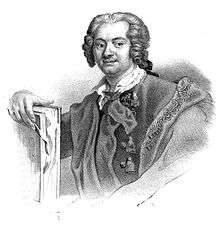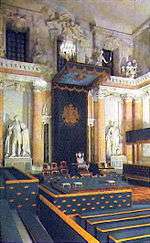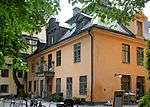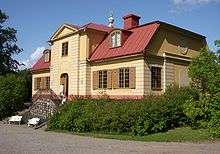Carl Hårleman




Baron Carl Hårleman (27 August 1700 – 9 February 1753) was a Swedish architect.
Hårleman was born in Stockholm, son of the garden architect and head of the royal parks and gardens Johan Hårleman, who had been ennobled in 1698. He began his architectural training under Göran Josua Adelcrantz (1668-1739). After receiving a state scholarship, he left Sweden for studies abroad in 1721, first going to Paris, where he spent four years as a student at the Royal French Academy of Architecture and the French Academy of Art. He later continued to Italy and was called back to Sweden while in Venice in 1727.
In 1728, upon the death of Nicodemus Tessin the Younger, Hårleman was appointed court intendant and subsequently in 1741, after Tessin's son Carl Gustaf Tessin had been made a member of the privy council, his successor as court superintendent. He was elected member of the Royal Swedish Academy of Sciences in 1744, was created a baron in 1747 and appointed Master of Ceremonies of the Royal Orders in 1748.
Hårleman completed the Royal Palace in Stockholm, begun by Nicodemus Tessin the younger after fire had destroyed the medieval castle, in 1697. He was particularly responsible for the interiors and employed a large number of qualified artisans for the work. The work on the interiors of the palace had a beneficial effect on the state of furniture-making and other crafts in Sweden and helped introduce the rococo style to the country.
Hårleman restored Uppsala Cathedral and parts of Uppsala Castle, both of which had been severely damaged in the Uppsala city fire of 1702, with the ruins of the castle having also been used as a quarry for the palace project in Stockholm. On behalf of Uppsala University, he built the Consistory House (konsistoriehuset) and the conservatory building for the botanical garden of Linnaeus.
Among his other works are Fredrikshovs house, Stockholm (1731), the Orangery, Linnaean Garden, Uppsala (1744), the main tower of the Holmentornet industrial works, Norrköping (1750), the Sätuna manor near Uppsala (1752), the Stockholm Observatory (1753), the Orangery, Linnaean Garden, Uppsala (1744), Hörningsholm Castle (c. 1746) in Mörkö in the Södertälje Municipality, and the "King's Gate" (1748), Tureholm Castle (1740s) in Trosa Municipality, Åkerö manor house (1752–57) (completed by Carl Gustaf Tessin after Hårleman's death) in Södermanland, and the royal entrance to the Sveaborg island fortress off Helsinki, in Finland (then part of the Kingdom of Sweden), and which was featured on the Finnish 1000 FIM banknote issued in 1986.
Hårlemanska malmgård, or Hårleman House, at 88A Drottninggatan street in central Stockholm was the Hårleman family house. The property was owned in the late 1600s by Carl Hårleman's father Johan Harleman. The house was rebuilt and fitted with a new interior in 1748 by Carl Harleman in connection with his wedding.
Hårleman died in 1753 and is buried in the Klara Church in Stockholm. His last great work, made in the year of his death, was to design the new church in Landskrona, later named Sofia Albertina Church.[1]
Selection of works by Carl Hårleman
-
Fredrikshovs house, Stockholm (1731)
-

Orangery, Linnaean Garden, Uppsala (1744)
-

Holmentornet tower, industrial works, Norrköping (1750)
-

Sätuna manor near Uppsala (1752)
-

Old Observatory, Stockholm (1753)
-

Åkerö manor, Södermanland (1752–57)
-

Svindersvik summer residence, Nacka (1740s)
-

Hörningsholm Castle, Mörkö (c. 1746)
-

Tureholm Castle (1740s)
-

Sofia Albertina Church, Landskrona (1753)
References
- ↑ Swedish Encyclopedia "Lilla Uppslagsboken" 1958, Förlagshuset Norden AB, Malmö, volume 6 of 10, article "Landskrona" (column 227), comment - article only states that he designed the new church in Landskrona, but it seems plausible that this must have been his last greater task. The old church was demolished in 1753, the same year as Hårleman died.
- (Swedish) Göran Alm, Carl Hårleman och den svenska rokokon, Lund: Signum, 1993.
- Riitta Koskinen, Suomalainen kartano, Helsinki: SKS, 2013.
- (Swedish) Runeberg.org - Svenskt biografiskt handlexikon - Carl Hårleman